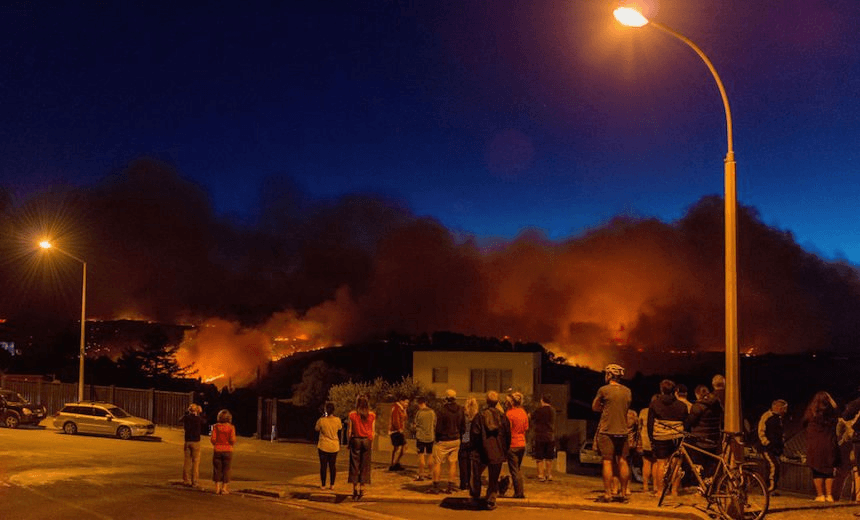As wildfire continues to ravage the Port Hills above Christchurch, questions are being raised about the scale and efficiency of the official response. When it comes to communicating with the public following a major emergency, why are the lessons of Christchurch and Kaikōura still unlearned, asks James Dann.
Christchurch is flat and largely featureless, one- and two-storey dwellings slowly encroaching onto the patchwork of the Canterbury Plains. The Port Hills frame the city, helping you reset your compass as you navigate the grid of the CBD or the sprawl of the suburbs. You can see them from anywhere – which is why the whole city has been transfixed since Monday night, as the fires have spread across the hills. We’ve watched as the smoke first emerged, as it seemed to abate, and then in horror as it rapidly moved through the valleys behind the Cashmere Hill from around midday yesterday.
I had an excellent view from my office at RDU* in the CBD, and spent the afternoon watching, tweeting, trying to find more information about what was going on. Wildfires are unpredictable by their nature, but it certainly seemed to me that the emergency services were not prepared for the speed and scale of this event. Our first reports were coming from social media – such as when the power went out over large chunks of the city – but obviously the information there was user-sourced and not necessarily verified. All through the afternoon, there was a paucity of information; the first media outlet to really recognise the significance of the days events was RNZ, that ran an extended Checkpoint from 5pm. The coverage on Newshub at 6 was far superior to OneNews, with two reporters at each end of the fire, providing multiple reports.
I grew up in Cashmere, at the foot of Westmorland, one of the suburbs that was evacuated yesterday afternoon. Both my parents and my brother still live there. I have been checking in with them since Monday to see whether they were ok, but when I rang my mum yesterday afternoon, she was appalled at the lack of information. I was able to relay information, mainly sourced off of twitter, but also from the CCC website. Mum mentioned the horrendous traffic on the roads, and how long it took for them to get back home. The situation with rubber-neckers was upsetting, but on one level, kind of understandable. There was very little information about the fire, so many people decided the best way to find out would be to go and look themselves. If there had been clear information about the danger earlier – and also asking people to keep the roads clear for emergency services and residents – then much of this could have been avoided.
Updates were few and far between, and coming in piecemeal fashion from a range of sources – the police, the council, the lines company Orion, Transport for Christchurch. There seemed to be no co-ordination between the agencies, and this wasn’t made much better by the state of emergency that was declared around 6pm. The Christchurch Civil Defence twitter account didn’t even send out its first tweet about the fire until 7:33pm.
As was clear with the response to Kaikōura, and also to the initial Christchurch quakes, our Civil Defence is simply not fit for purpose in 2017.
Around 11pm, a number of news outlets, as well as the City Council, carried the news that 40 houses had burnt down, citing as Civil Defence representative as their source. After much confusion, this was clarified as 4 – not 40. It may have been a simple mistake, someone mishearing a number over a bad phone line or walkie talkie, but it will have caused a large amount of panic as many people were trying to get the latest information before heading to sleep.
It is clear that Civil Defence have major issues communicating clearly and accurately. The Minister is right – the response was too slow. But instead of lashing out and trying to pass the blame, he would do well to have a hard look at his own role. The dysfunction at the Ministry created in his image, CERA, led to an awful relationship with the public and a reluctance to release any information unless compelled to. As Christchurch has shown in the last few years, New Zealand is vulnerable to all sorts of disasters – earthquakes, flooding, fire – and while we can’t predict when they will happen, we can at least be well prepared. Having clear and concise communication is absolutely vital to keeping New Zealanders informed and safe – and as it stands, Civil Defence appear to be unable to do that.
*RDU has been well aware of the severity of the situation since Monday night, when our transmitter on Marley Hill was taken out of action.
The Society section is sponsored by AUT. As a contemporary university we’re focused on providing exceptional learning experiences, developing impactful research and forging strong industry partnerships. Start your university journey with us today.
